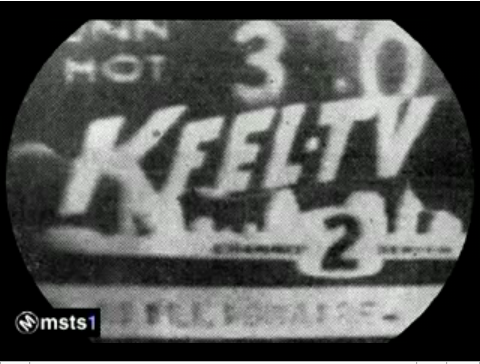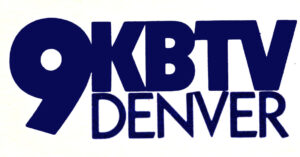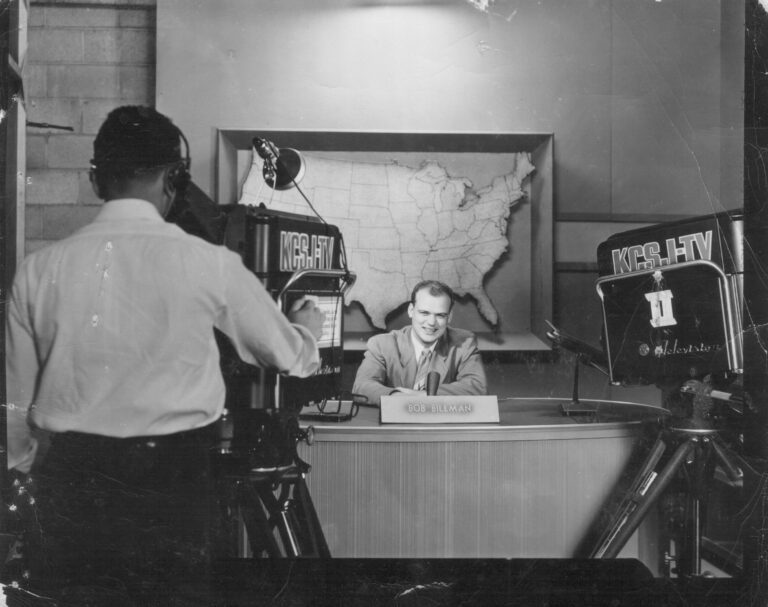More historical details, pictures and sound coming soon.
Denver was one of the last major cities to begin television broadcasting due to a hold in issuing television licenses during the late 1940s.
The first station to make it on the air when the hold was lifted was KFEL, signing on July 18, 1952. Despite having all the major networks available to affiliate with, KFEL aligned with the DuMont Network, which would be defunct in 1956.
The station continued as an independent outlet, with ownership changes and changes of call letters to KTVR and later KCTO before the station was bought by Tribune Broadcasting in 1965 and the current call letters KWGN were adopted.
It maintained an independent news operation with a then-unique primetime newscast at 9PM alongside syndicated programming, reruns of television shows and movies. A longtime staple of its daytime programming was “Blinky’s Fun Club” featuring Russell Scott as “Blinky the Clown”.
Channel 2 returned to network affiliation in 1996 with the fledgling WB Network (now the CW).
Since 2008, KWGN has been part of a duopoly arrangement with KDVR (Fox31) with the two stations sharing facilities and a large combined news operation with staff appearing on both stations. They are currently owned by Nectar Media Group.
More historical details, pictures and sound coming soon.
KLZ signed on the air on November 1, 1953, inheriting the CBS affiliation from its radio predecessor KLZ-AM.
For much of the 1950s and 60s KLZ dominated the local ratings, with a strong news department led by Jim Bennett and Carl Akers. KLZ led a significant legal challenge that finally allowed cameras into Colorado courtrooms which allowed the station to cover the John Gilbert Graham airline bombing case. Numerous on-air and behind the scenes staff from those years are in the BPC Hall of Fame.
KLZ was sold to McGraw-Hill in 1970 and the call letters changed to the current KMGH. Bob Palmer, Starr Yelland and Warren Chandler and John Lindsey featured in their 1970s anchor teams. Bertha Lynn, Ernie Bjorkman and Anne Trujillo had lengthy stints on the anchor desk in the 1990s-2000s.
The network affiliation switched to ABC in September, 1995 as part of Denver’s “Big Switch” of network affiliations.
KMGH’s moved from its longtime home on Speer Boulevard in Denver to a brand new facility north of downtown Denver in 2024.
More historical details, pictures and sound coming soon.
The second station to make it on the air in Denver was KBTV, signing on October 12, 1952. It lost its original affiliation with CBS when KLZ went on the air, and aired ABC programming until 1995 when it picked up NBC programming.
The station got a major boost when it hired Carl Akers to do features, and later anchor its news programs. Akers and Roger Ogden built a news department that was unrivaled in the late 70s and 80s, sometimes achieving over 50% of the viewing audience. Ed Sardella, Mike Landess, Stormy Rottman were among the large team of award-winning journalists that kept Channel 9 on top for years.
Channel 9 was an innovator in remote mobile news gathering in the 1970s and it’s news photographers were nationally recognized numerous times for elevating the visual storytelling of television news.
Corporate parent Gannett changed the call letters to KUSA in 1984 to align the station with Gannett’s then startup USA Today newspaper.
Later, Adele Arakawa, Ron Zappolo, Mark Koebrich were among personalities the kept the station’s legacy going in the 1990s and 2000s. The station continues to be the top-rated Denver station in the 2020s.
More historical details, pictures and sound coming soon.
The last of Denver’s original 4 stations to sign on was KOA-TV Channel 4, which signed on Christmas Eve 1953 as Denver’s NBC affiliate. The ownership group at that time included NBC legend Bob Hope, who appeared at the station when it moved to its current location on Lincoln Street in 1959.
General Electric bought KOA’s TV and radio operation in 1968, Bob Palmer and Ed “Weatherman” Bowman were key on-air figures in the 1960s. KOA became the first station in Denver to have a woman and African-American news anchor when it hired Reynelda Muse. After a stint at Channel 7, Palmer returned to Channel 4 in 1982 and stayed until his retirement in 1992.
After a sale which separated the KOA radio and television operations, the station was renamed KCNC (Colorado’s News Channel) in 1983. General Electric re-acquired the station when it bought NBC and it was Denver’s first network owned and operated station.
Roger Ogden, architect of Channel 9s news dominance, came to KCNC in 1991 and began to expand its local news programming and coverage of local events like covering the Boulder Bolder and High School sports.
Channel 4’s longtime NBC affiliation ended in the “Big Switch” of 1995, when the station was transferred to CBS and Westinghouse. It continues today as a CBS O&O under the CBS News Colorado brand.
More historical details, pictures and sound coming soon.
KCSJ became the first television station in Pueblo in 1953. Though it didn’t last long, Bill Baker wrote an interesting overview of what life was like working at a low-budget station in Southern Colorado in the mid 1950s.






